National Park Week:
9 Reasons We Love Acadia
April 22nd, 2024
April 22nd, 2024
It’s National Park Week (April 20-28, 2024), a celebration of our National Parks! It’s an ideal opportunity to let our admiration for Acadia shine (not that we need a reason–we tend to brag on our amazing coastal Maine park all year.)
While each National Park has its own unique charm and natural beauty, we’re admittedly a bit biased. So, allow us to wax poetic for a minute about Acadia–its historic trails and carriage roads, its tough-but-fragile summit vegetation–and also give a nod to the people who work to make this park hum, from park staff and thoughtful visitors to the researchers whose efforts help ensure Acadia’s forests, marshes, wildlife, and wildflowers remain resilient well into the future.
Friends of Acadia is supremely proud to help protect this park.
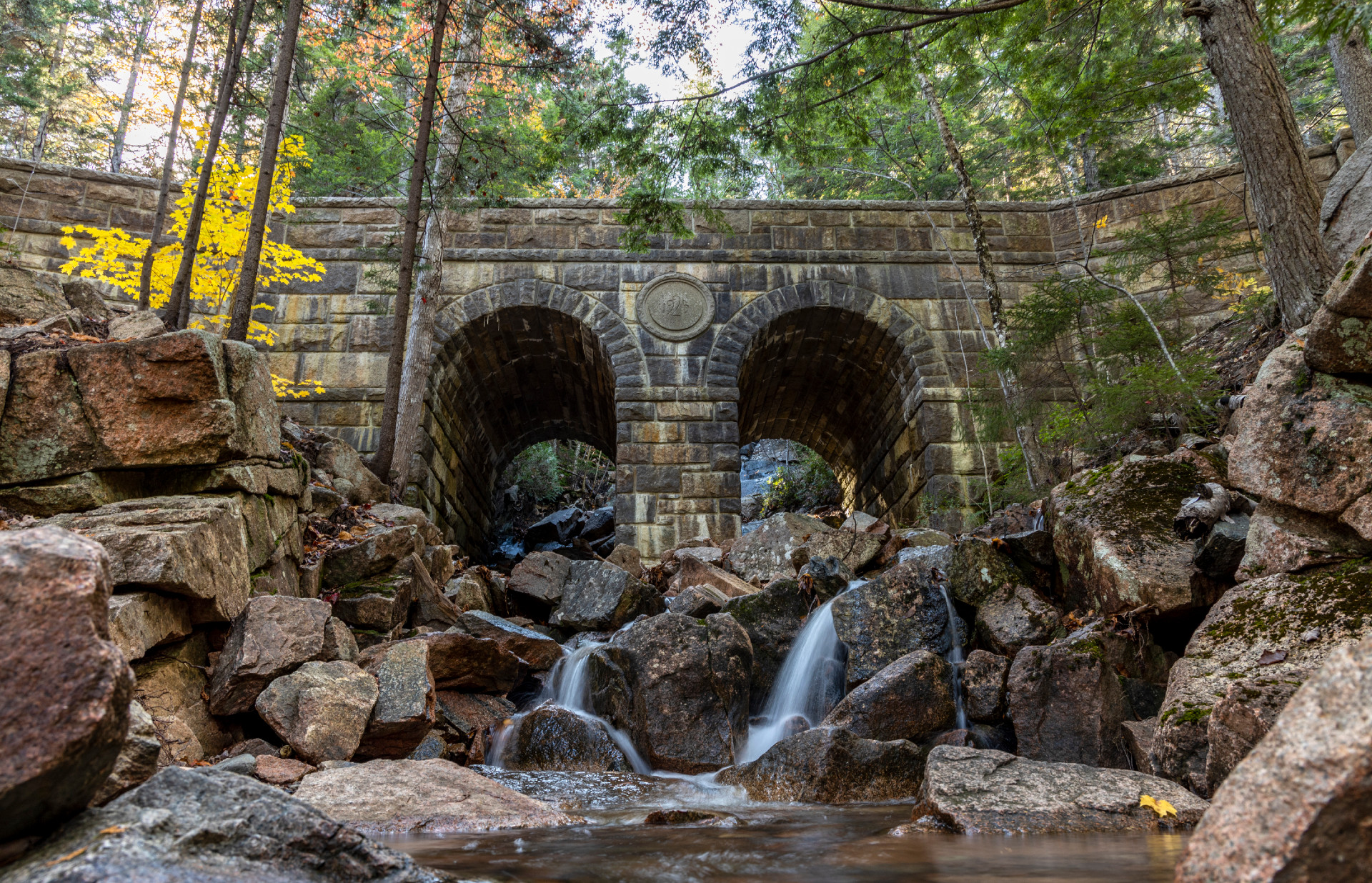
Deer Brook flows under the Deer Brook carriage road bridge in Acadia National Park. (Photo by Lily LaRegina/Friends of Acadia)
In Acadia, no other human-made structures are as well-recognized as the historic bridges on the carriage roads. Sixteen of the 17 stone bridges were designed and financed by John D. Rockefeller, Jr. (including the Deer Brook Bridge, pictured above). It is said that, during the bridges’ construction, Rockefeller requested that the stonecutters avoid cutting the facing too well, lest the bridges lose their rustic appeal. Like the members of a family, each has its own unique personality, but it’s not tough to see they’re related.
 While those bridges were well-built from the start, restoration is essential to keep them looking and functioning well. The restoration of the carriage road bridges is sponsored in part by donations from Friends of Acadia members. Read about Acadia’s masons who help preserve the park’s historic stone structures.
While those bridges were well-built from the start, restoration is essential to keep them looking and functioning well. The restoration of the carriage road bridges is sponsored in part by donations from Friends of Acadia members. Read about Acadia’s masons who help preserve the park’s historic stone structures.
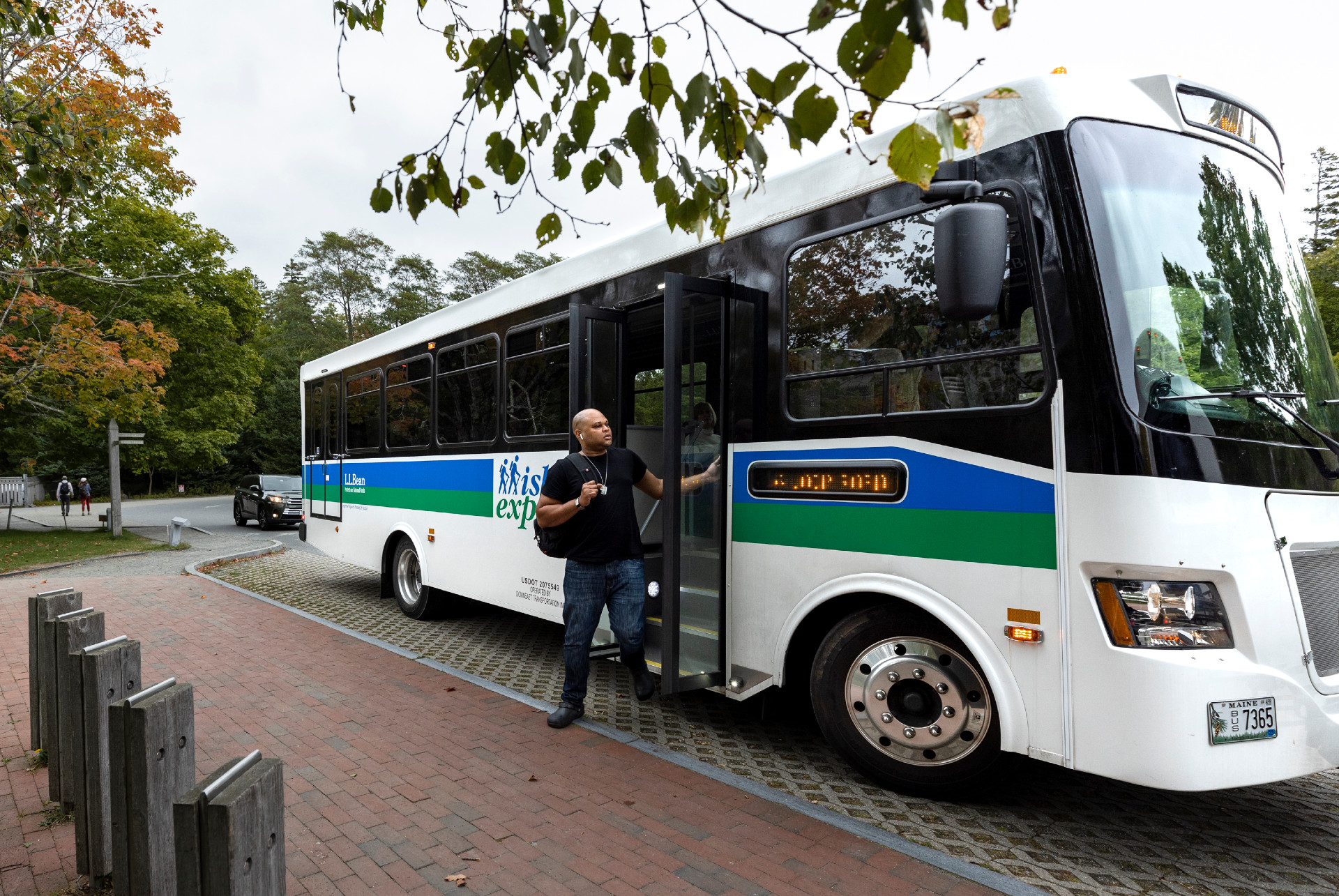
A visitor disembarks off an Island Explorer shuttle at the Jordan Pond House in Acadia National Park. (Photo by Lily LaRegina/Friends of Acadia)
Car-free exploration enables us to immerse ourselves in the park we love (rather than being immersed in traffic), and it’s a more environmentally friendly way to experience and steward Acadia, too. That’s why we’re big fans of the fare-free Island Explorer.
The Island Explorer runs daily from June into October on Mount Desert Island. The bus system includes multiple routes to and from destinations like Sand Beach, Jordan Pond, Sieur de Monts, Otter Cliffs, downtown Bar Harbor, Northeast Harbor, Southwest Harbor, as well as many island campgrounds and hotels. Service also runs on the Schoodic Peninsula. It’s free to ride, although you will need an Acadia National Park entry pass to visit park locations. All Island Explorer buses are equipped with bicycle racks, too! Check our tips for How to Be an Island Explorer Pro.
 Friends of Acadia has been a partner in the Island Explorer since its inception and helped facilitate a partnership with L.L.Bean. The Island Explorer receives funding from the state and federal government, as well as grants from L.L.Bean, Friends of Acadia, local towns, businesses, and passenger donations.
Friends of Acadia has been a partner in the Island Explorer since its inception and helped facilitate a partnership with L.L.Bean. The Island Explorer receives funding from the state and federal government, as well as grants from L.L.Bean, Friends of Acadia, local towns, businesses, and passenger donations.

An Eastern newt (Notophthalmus viridescens) is found along the edge of Great Meadow in Acadia National Park. (Photo by Sam Mallon/Friends of Acadia)
As if the evergreen forests, marsh, clear ponds, Wild Gardens (and bog!), weren’t enough, Acadia has the pleasure of sitting alongside the Atlantic. Diverse ecosystems abound here. Park visitors might spot songbirds and seabirds, as well as newts and porcupines and seals and sea anemones. The tide pools alone are a window into a marvelous tidal world, with crabs tucking into the safety of seaweed while barnacles and snails cling to the rock.
 That’s why Friends of Acadia invests in a series of Wild Acadia initiatives to help park ecosystems be resilient to the changes happening within and around them. This collaborative and science-based approach seeks to understand the stresses to Acadia’s resources and new ways to manage park ecosystems so that they are better equipped to handle changing environmental conditions. We also believe learning about these ecosystems helps us develop a deeper understanding of the natural environment and our role in it. That’s why inspiring the Next Generation of Stewards is a big part of our mission.
That’s why Friends of Acadia invests in a series of Wild Acadia initiatives to help park ecosystems be resilient to the changes happening within and around them. This collaborative and science-based approach seeks to understand the stresses to Acadia’s resources and new ways to manage park ecosystems so that they are better equipped to handle changing environmental conditions. We also believe learning about these ecosystems helps us develop a deeper understanding of the natural environment and our role in it. That’s why inspiring the Next Generation of Stewards is a big part of our mission.
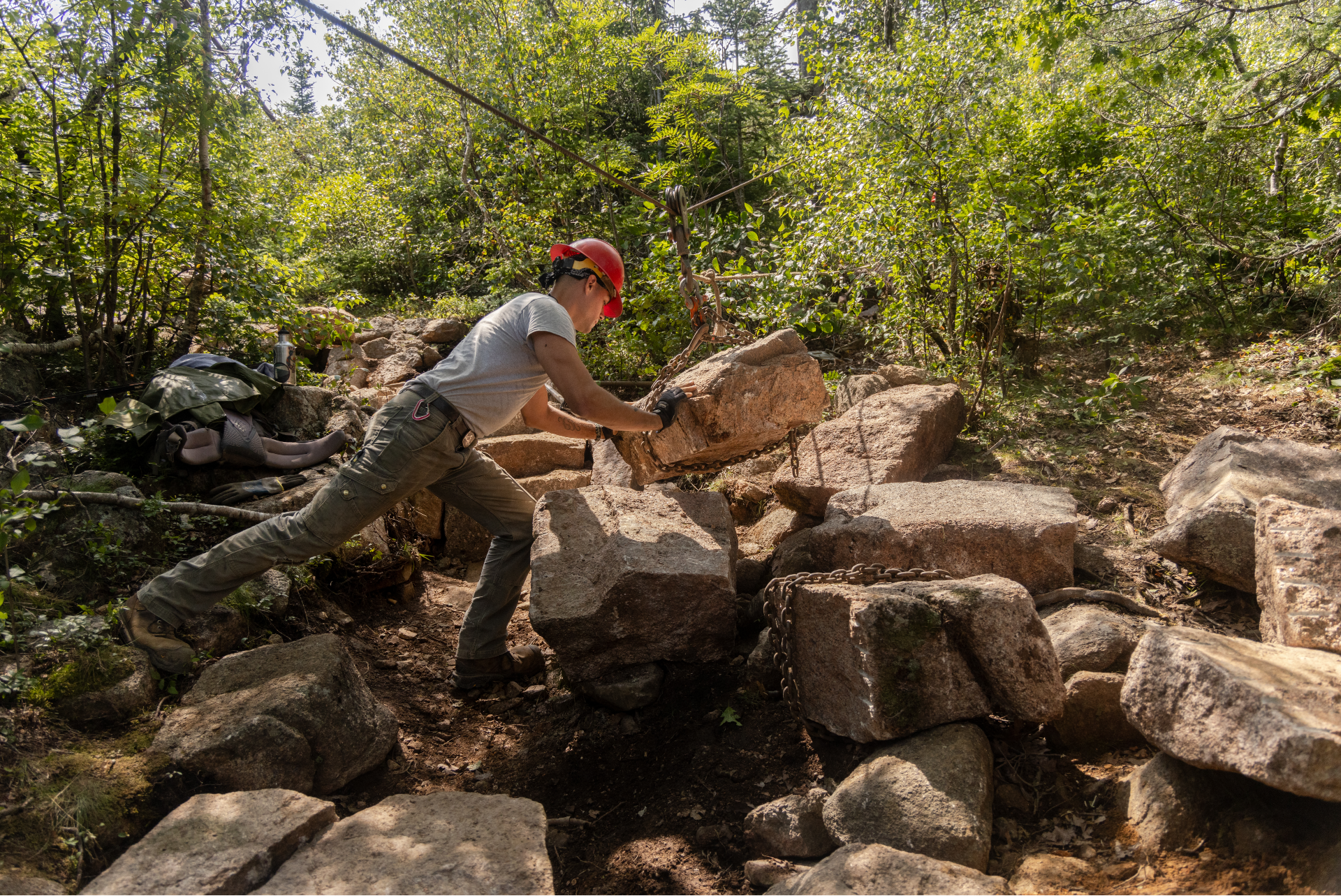
Zach Dixon of the Acadia National Park Trail Crew uses a highline system to move pieces of granite to build granite steps during maintenance on Cadillac North Ridge Trail in Acadia National Park. (Photo by Sam Mallon/Friends of Acadia)
Whether you’re wandering along Ocean Path marveling at the craggy and picturesque coastline, hoofing it up a staircase comprised of very heavy rock, or making your determined way toward a summit marker under the guidance of well-placed cairns, you’ll inevitably come to realize: there sure is a lot of granite around here. That pink granite is prolific in Acadia, and while nature gets the credit for the bulk of its presence in the park, some pieces have been moved around to create staircases, Bates cairns, and coping stones. Learn more about the geology of Acadia (volcanoes, erosion, and glaciers, oh my!)
 How does the park move all that heavy rock to build, say, a granite staircase? With a lot of physical effort and the help of highlines and other equipment. It’s wonderfully interesting: Heavy Lifting: Moving heavy rock is a big part of building and maintaining trails in Acadia National Park.
How does the park move all that heavy rock to build, say, a granite staircase? With a lot of physical effort and the help of highlines and other equipment. It’s wonderfully interesting: Heavy Lifting: Moving heavy rock is a big part of building and maintaining trails in Acadia National Park.

A park visitor rides her bike on the Eagle Lake Carriage Road in Acadia National Park. (Photo by Yehyun Kim/Friends of Acadia)
Another of Acadia’s human-made assets (also courtesy of John D. Rockefeller, Jr.) are the 45 miles of rustic carriage roads. Originally created so Rockefeller could travel on motor-free byways via horse and carriage into the heart of Mount Desert Island, these carriage roads were built to align with the contours of the land, spare trees, and take advantage of scenic views. Today the carriage roads welcome walkers, bike riders, cross-country skiers, and snowshoers – and yes, horses and carriages, too! (Read more on nps.gov)
 Since Friends of Acadia’s inception in 1986, the trails and carriage roads have been a central focus of our work. Our Carriage Road Endowment helps ensure that the carriage road system will be maintained.
Since Friends of Acadia’s inception in 1986, the trails and carriage roads have been a central focus of our work. Our Carriage Road Endowment helps ensure that the carriage road system will be maintained.
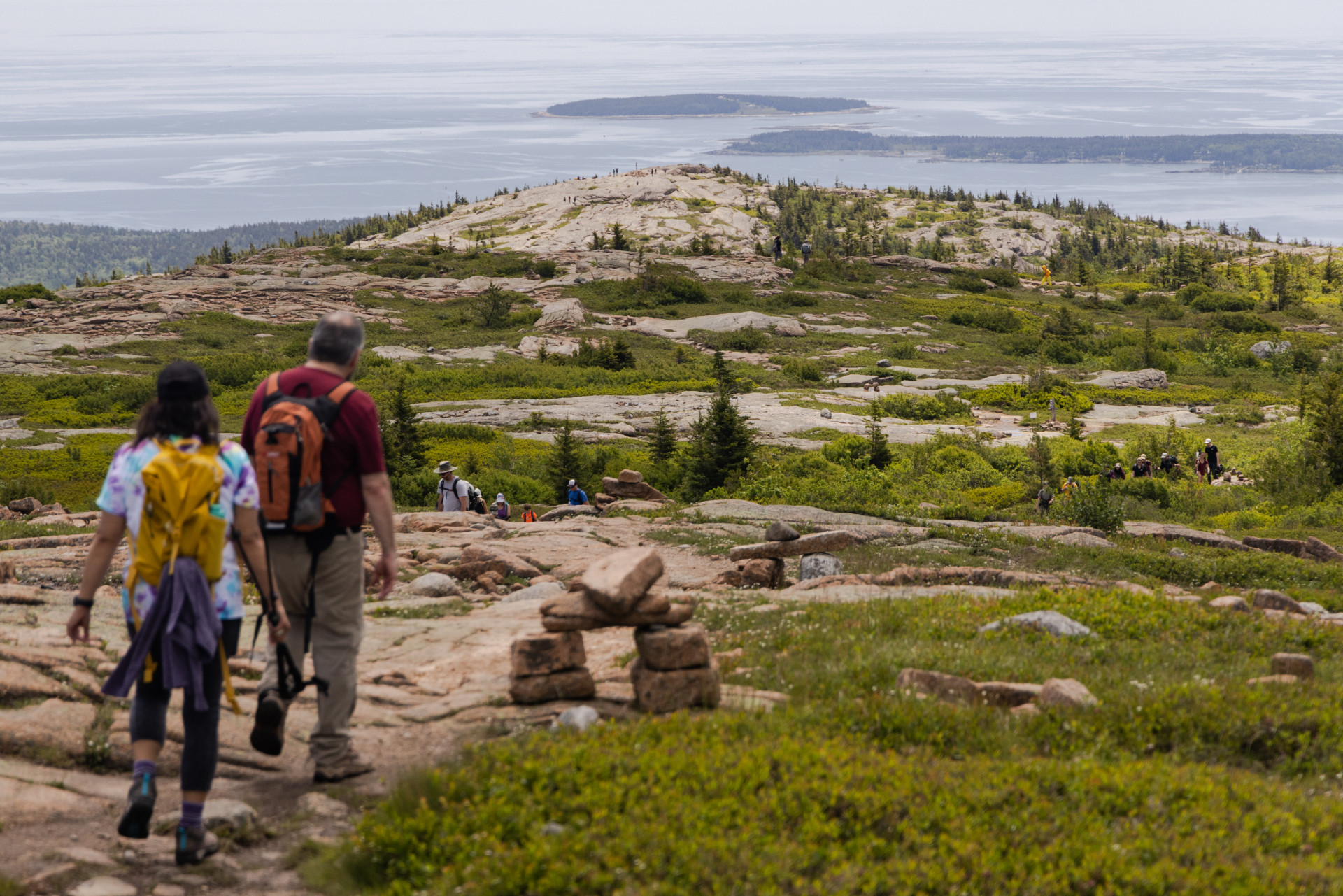
Volunteers hike bags of soil up Sargent South Ridge and Hadlock Brook Trails during the Soil on Summits hike in 2023, a volunteer effort to bring soil up to the summits, where revegetation projects will take place. (Photo by Sam Mallon/Friends of Acadia)
On many of Acadia’s summits, squat spruces and balsam firs give way to rolling expanses of pink granite splashed with pale green lichen. In the cracks between the rock, resolute shrubs and wildflowers hold fast in shallow soil. That vegetation is tough, yet fragile. The plants and shrubs on Acadia’s mountains are adapted to tough conditions like wind, fog, ice, snow, and direct sunlight. But climate change, extreme weather events, and trampling by humans has damaged these plant communities.
 That’s why Friends of Acadia supports the park’s summit restoration work to keep the unique ecosystems on Acadia’s summits healthy, diverse, and adaptable. (It’s also why staying on trail is so helpful when hiking in Acadia – or anywhere, really. To avoid trampling those subalpine plants and shrubs, rock-hopping rules!)
That’s why Friends of Acadia supports the park’s summit restoration work to keep the unique ecosystems on Acadia’s summits healthy, diverse, and adaptable. (It’s also why staying on trail is so helpful when hiking in Acadia – or anywhere, really. To avoid trampling those subalpine plants and shrubs, rock-hopping rules!)

Emma Lanning (front), Acadia National Park Biological Science Technician, and Jesse Wheeler, Acadia National Park Vegetation Program Manager and Biologist, collect seeds from native plants in Great Meadow in Acadia National Park. The seeds will be used as part of the park’s ongoing revegetation and summit restoration projects to help learn which methods are most successful. (Photo by Lily LaRegina/Friends of Acadia)
With its wealth of habitats and protected fields, forests, wetlands, and waters, Acadia National Park is an unparalleled natural laboratory, and there’s a great deal of science happening in Acadia National Park. In addition to the aforementioned summit restoration work, researchers are studying risk factors for the spread of southern pine beetle, recording bird sounds to help enhance bird ecology research, assessing visitors’ experiences using the Cadillac reservation system. They’re studying how small mammals in the park are responding to ecosystem restoration projects and using imagery to understand how warming temperatures impact when fall foliage appears. Check out all of last year’s research: 2023 Acadia Science Year in Review.
 Park visitors can be citizen scientists! Our casual observations of the wildlife, insects, plants, and trees can serve a scientific purpose. By uploading our photos to phone apps such as iNaturalist or eBird, we’re contributing to a growing cache of data that’s used by scientists in Acadia National Park and around the world. Be a Citizen Scientist in Acadia.
Park visitors can be citizen scientists! Our casual observations of the wildlife, insects, plants, and trees can serve a scientific purpose. By uploading our photos to phone apps such as iNaturalist or eBird, we’re contributing to a growing cache of data that’s used by scientists in Acadia National Park and around the world. Be a Citizen Scientist in Acadia.
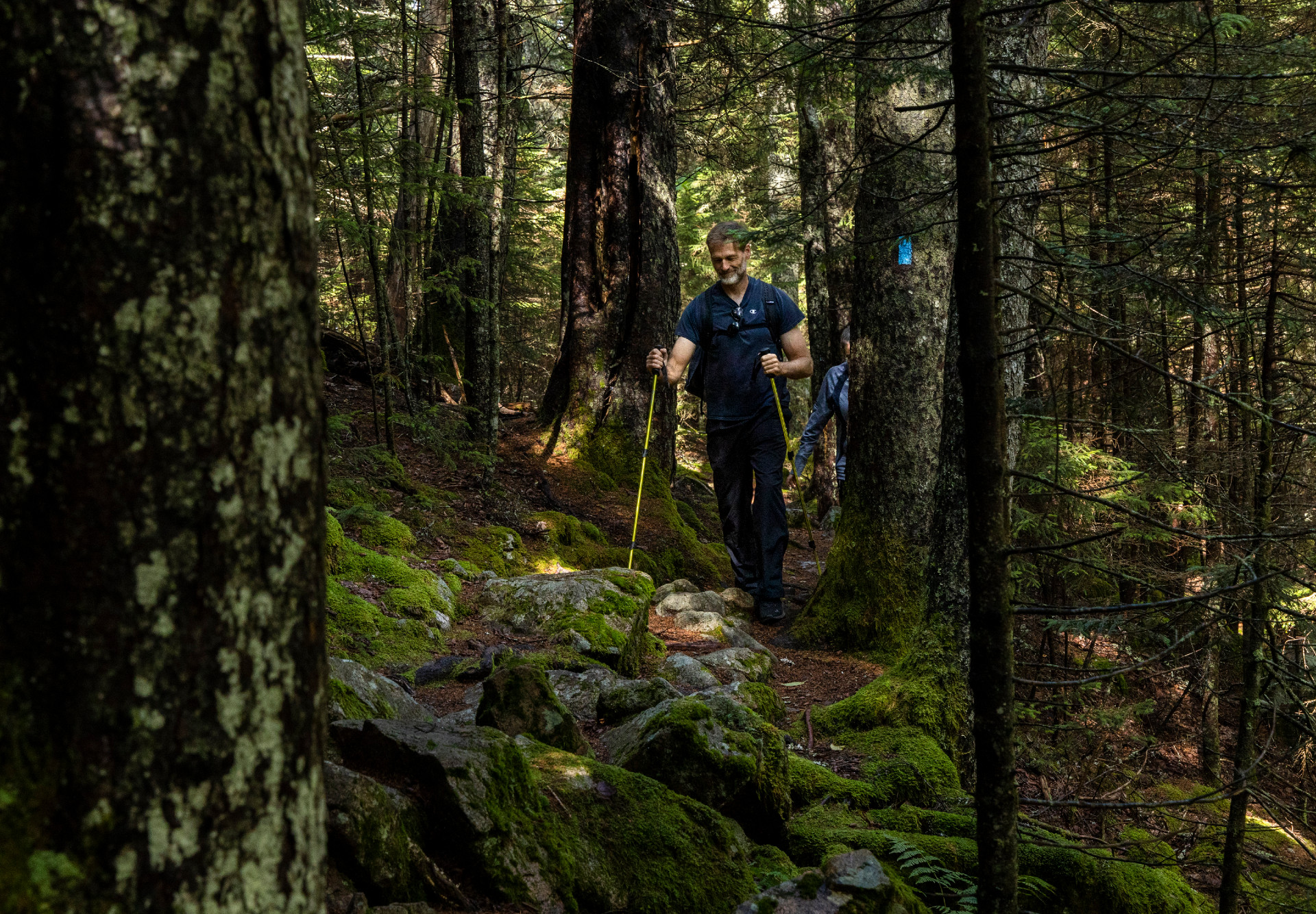
Dave Ouellette and Alexandra Gould, of Newburyport, Mass., hike the Bernard Mountain Trail in Acadia National Park. (Photo by Lily LaRegina/Friends of Acadia)
Acadia National Park boasts 158 miles of hiking trails. Perhaps you’ve hiked a lot of them. And probably you also love to marvel at the vistas, the winding bog walk, the granite steps that invite you up, up, up.
 To help ensure Acadia’s trails continue to look marvelous for decades to come, Friends of Acadia and Acadia National Park embarked upon the Acadia Trails Forever partnership back in 2000 to restore and maintain the park’s hiking trail system. Acadia was the first national park in the country to have an endowed trail system, and the Acadia Trails Forever model has since been adapted by other national parks and their partners working together to preserve trail systems. Pretty cool! We also help the park maintain trails through our stewardship volunteer program (and you can help out, too)! Learn more: Help Maintain the Historic Carriage Roads and Trails of Acadia!
To help ensure Acadia’s trails continue to look marvelous for decades to come, Friends of Acadia and Acadia National Park embarked upon the Acadia Trails Forever partnership back in 2000 to restore and maintain the park’s hiking trail system. Acadia was the first national park in the country to have an endowed trail system, and the Acadia Trails Forever model has since been adapted by other national parks and their partners working together to preserve trail systems. Pretty cool! We also help the park maintain trails through our stewardship volunteer program (and you can help out, too)! Learn more: Help Maintain the Historic Carriage Roads and Trails of Acadia!

Recreation Fee Clerk Scout Cutler checks park passes for visitors at the Sand Beach entrance station at Acadia National Park. (Photo by Ashley L. Conti/Friends of Acadia)
Whether working directly with park visitors or behind the scenes, seasonally or year-round, the talented and dedicated staff of Acadia National Park are the people who make the park hum. They work hard and wear many hats, keeping the park in incredible shape, keeping park visitors safe, and rising to the occasion as visitation has reached peak levels in recent years. We immensely appreciate the work they do to steward the park and create incredible visitor experiences day after day. Read more about some of the awesome and hardworking park staff we’ve profiled.